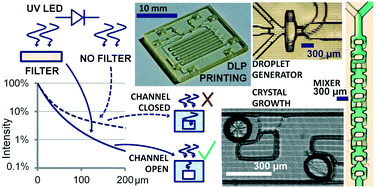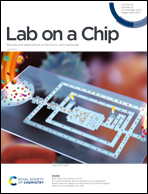Accurate and rapid 3D printing of microfluidic devices using wavelength selection on a DLP printer†
Abstract
The use of microfluidics on synchrotron X-ray beamlines represents an advanced sample preparation and delivery platform for state-of-the-art X-ray characterization of micro-samples. The recent developments of 3D printing technologies have opened possibilities for rapid fabrication of complex microfluidic devices. One of the major challenges in 3D printing of microfluidic devices using a digital light processing (DLP) desktop printer is that the static liquid resin trapped in the channels, once the “ceiling” is printed, still receives small doses of light through the subsequently printed layers. This easily triggers partial polymerisation of the resin which impedes its flushing out of the channels after completion of the printing session. We show here that it is possible to gain better control over the resin polymerisation and improve the quality of the microfluidic devices by efficiently reducing the penetration depth of the UV LED light through wavelength selection combined with a careful choice of absorber and photo-initiator materials. We produced and tested several structures using a slightly modified desktop printer at 385 nm wavelength with 37 × 37 μm2 pixel resolution at a printed layer thickness of 25 μm. The structures include particle filters, mixers, droplet generators and droplet storage traps with features below 100 μm. We demonstrate crystallisation of model inorganic and organic compounds in trapped droplets and assess the feasibility of in-device X-ray diffraction experiments. This research opens the path for the use of 3D printed microfluidic devices on X-ray beamlines.



 Please wait while we load your content...
Please wait while we load your content...